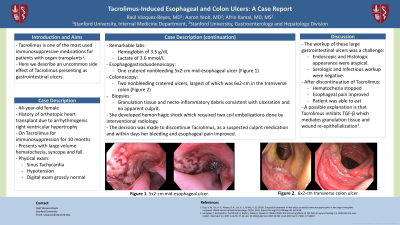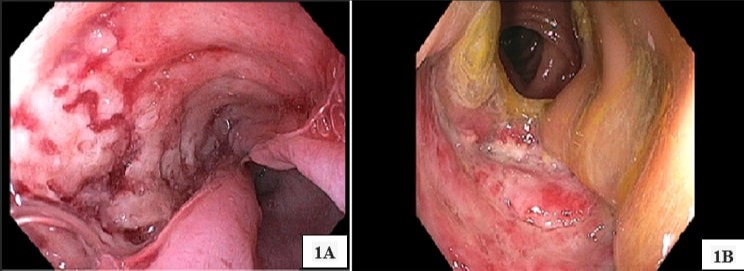Back


Poster Session C - Monday Afternoon
Category: GI Bleeding
C0338 - Tacrolimus-Induced Esophageal and Colon Ulcers: A Case Report
Monday, October 24, 2022
3:00 PM – 5:00 PM ET
Location: Crown Ballroom

Has Audio

Raul Vazquez-Reyes, MD
Stanford University
Palo Alto, CA
Presenting Author(s)
Award: Presidential Poster Award
Raul Vazquez-Reyes, MD1, Aaron J. Yeoh, MD1, Afrin N. Kamal, MD, MS2
1Stanford University, Palo Alto, CA; 2Stanford University, Redwood City, CA
Introduction: Tacrolimus (TC) is one commonly used immunosuppressive medications for patients with solid organ transplants. Here we describe an uncommon side effect of TC presenting with GI tract ulcers.
Case Description/Methods: 44-year-old female with past medical history of orthotopic heart transplant due to arrhythmogenic right ventricular hypertrophy 10 months ago, on TC and mycophenolic acid for immunosuppression who presented with large volume hematochezia, syncope and fall. Her physical exam was notable for sinus tachycardia, hypotension and digital exam was grossly normal without presence of blood. Labs showed a hemoglobin of 3.5 g/dL and a lactate of 3.6 mmol/L, which both improved following resuscitation. Esophagogastroduodenoscopy showed a cratered nonbleeding 5x2-cm mid-esophageal ulcer (Figure 1A). Colonoscopy revealed 2 nonbleeding cratered ulcers, largest of which was 6x2-cm in the transverse colon (Figure 1B). Biopsies revealed granulation tissue and necro-inflammatory debris consistent with ulceration and no apparent culprit. Histologic and serologic studies for infectious etiologies (e.g., Cytomegalovirus (CMV), Tuberculosis) were unrevealing. Her clinical course was notable for daily fevers, severe esophageal pain and recurrent hematochezia requiring daily blood transfusions. She ultimately developed hemorrhagic shock and imaging demonstrated active extravasation from the terminal ileum. Interventional radiology performed 2 coil embolizations that successfully controlled the acute bleeding. The decision was made to discontinue TC, as likely the culprit medication. Within days, her GI bleeding resolved, esophageal pain improved, and she was able to eat. Immunosuppression was transitioned to cyclosporine and prednisone, and she was discharged.
Discussion: This report highlights a rare presentation of TC-induced ulcers of the GI tract. The workup of large GI ulcers was a challenge as endoscopic and histologic appearance were not consistent with common etiologies in the post-transplant patient. We considered ischemia, but the patchy distribution and characteristics of these ulcers were atypical. CMV is a common infection in post-transplant patients, but these studies were consistently negative. All other workup was unremarkable. We turned to medications and discontinued TC with rapid improvement in all symptoms. A possible explanation is that TC inhibits TGF-β which mediates granulation tissue and wound re-epithelialization. Discontinuation of TC in similar cases can be considered.

Disclosures:
Raul Vazquez-Reyes, MD1, Aaron J. Yeoh, MD1, Afrin N. Kamal, MD, MS2. C0338 - Tacrolimus-Induced Esophageal and Colon Ulcers: A Case Report, ACG 2022 Annual Scientific Meeting Abstracts. Charlotte, NC: American College of Gastroenterology.
Raul Vazquez-Reyes, MD1, Aaron J. Yeoh, MD1, Afrin N. Kamal, MD, MS2
1Stanford University, Palo Alto, CA; 2Stanford University, Redwood City, CA
Introduction: Tacrolimus (TC) is one commonly used immunosuppressive medications for patients with solid organ transplants. Here we describe an uncommon side effect of TC presenting with GI tract ulcers.
Case Description/Methods: 44-year-old female with past medical history of orthotopic heart transplant due to arrhythmogenic right ventricular hypertrophy 10 months ago, on TC and mycophenolic acid for immunosuppression who presented with large volume hematochezia, syncope and fall. Her physical exam was notable for sinus tachycardia, hypotension and digital exam was grossly normal without presence of blood. Labs showed a hemoglobin of 3.5 g/dL and a lactate of 3.6 mmol/L, which both improved following resuscitation. Esophagogastroduodenoscopy showed a cratered nonbleeding 5x2-cm mid-esophageal ulcer (Figure 1A). Colonoscopy revealed 2 nonbleeding cratered ulcers, largest of which was 6x2-cm in the transverse colon (Figure 1B). Biopsies revealed granulation tissue and necro-inflammatory debris consistent with ulceration and no apparent culprit. Histologic and serologic studies for infectious etiologies (e.g., Cytomegalovirus (CMV), Tuberculosis) were unrevealing. Her clinical course was notable for daily fevers, severe esophageal pain and recurrent hematochezia requiring daily blood transfusions. She ultimately developed hemorrhagic shock and imaging demonstrated active extravasation from the terminal ileum. Interventional radiology performed 2 coil embolizations that successfully controlled the acute bleeding. The decision was made to discontinue TC, as likely the culprit medication. Within days, her GI bleeding resolved, esophageal pain improved, and she was able to eat. Immunosuppression was transitioned to cyclosporine and prednisone, and she was discharged.
Discussion: This report highlights a rare presentation of TC-induced ulcers of the GI tract. The workup of large GI ulcers was a challenge as endoscopic and histologic appearance were not consistent with common etiologies in the post-transplant patient. We considered ischemia, but the patchy distribution and characteristics of these ulcers were atypical. CMV is a common infection in post-transplant patients, but these studies were consistently negative. All other workup was unremarkable. We turned to medications and discontinued TC with rapid improvement in all symptoms. A possible explanation is that TC inhibits TGF-β which mediates granulation tissue and wound re-epithelialization. Discontinuation of TC in similar cases can be considered.

Figure: Figure 1A. Nonbleeding 5x2-cm mid-esophageal ulcer
Figure 1B. Nonbleeding cratered 6x2-cm transverse colon ulcer
Figure 1B. Nonbleeding cratered 6x2-cm transverse colon ulcer
Disclosures:
Raul Vazquez-Reyes indicated no relevant financial relationships.
Aaron Yeoh indicated no relevant financial relationships.
Afrin Kamal indicated no relevant financial relationships.
Raul Vazquez-Reyes, MD1, Aaron J. Yeoh, MD1, Afrin N. Kamal, MD, MS2. C0338 - Tacrolimus-Induced Esophageal and Colon Ulcers: A Case Report, ACG 2022 Annual Scientific Meeting Abstracts. Charlotte, NC: American College of Gastroenterology.


